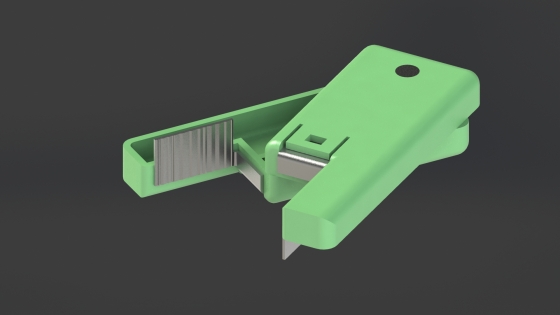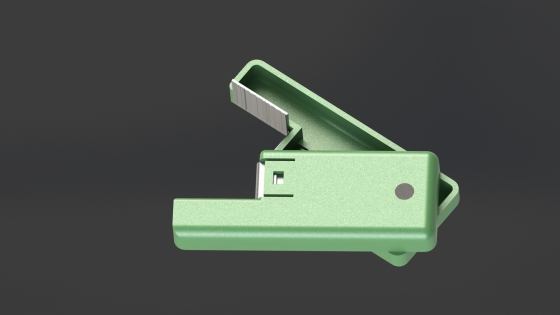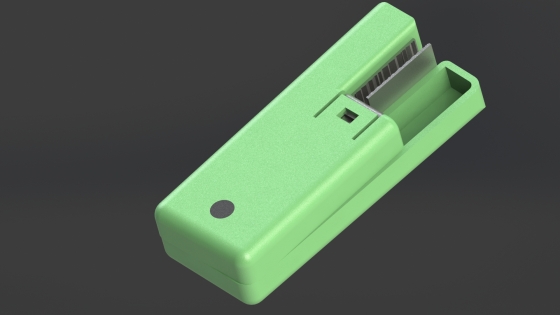DESIGN FOR MASS PRODUCTION – BLOG 21 (EVALUATE) / PRODUCTION TECH
Part of this assignment was also analysing the production aspect of our clip in conjunction with our production paper. Because of this, I have analysed the clip that I have designed and see how good it would be to put in to actual production. To start things of as a baseline, because my clip re design is based around the current one and more a revolution of it, there is not much to change for how it is produced, meaning it should fair up relatively well for production.
To start things off, I looked at other ways of producing the part and working with plastics.
Blow Moulding:
Ideal for producing light and thin parts as it has a very high stiffness ratio with its parts. It creates minimal warp in the plastic, making it ideal for producing complex shape in the plastic. However, the finish on them is not as good as injection moulded plastic. It is also not very ideal for producing shapes that includes sharp angles. Because of the nature of the blow moulding, thicker plastics also cannot be done with this process that may be necessary for the clips.
Rotational Moulding:
With this knowledge and my design, I have decided to just go with injection moulding as my choice of manufacturing again, the same process that is currently being used by active components. This decision is due to the effectiveness of injection moulding as a way of mass production, especially with something similar to the clip.
Part of the injection moulding process, I have also looked at the cost of achieving something like this to get my new clip design going and also calculated how much my clip would be to produce. The aim for myself in my design was to lower the cost (especially through labour) and it would not make sense if the clip itself would be more expensive to produce than it originally was when my aim was to reduce the cost
Here is a breakdown of my calculated cost:
*due to the limited time available, this is the best estimate that I could have done in order for me to get a close approximation of the potential tooling cost and price per unit for my clip. I have tried to get in contact with some engineering companies to get an approximate quote for my clip, however I did not get any proper response back to them (due to not having much benefits from them /just did not get any reply at all). However, I still believe that this method of me in calculating the cost of the clip is still effective and it offers a good baseline comparison as well with the current active component clip being produced.
FINAL CLIP PRODUCTION:
- 2x INJECTION MOULDED PARTS + AXLE
- 2x SHEET METAL TEETH
- 1x SPRING
2 PART MOULD WITH SIDE ACTION INJECTION MOULDING
PLASTIC:
- ABS plastic is high impact, high weather resistance
- Tough for wear and tear
- Economical and Low cost
- Stable and Light Weight
TEETH:
- 316 stainless is durable,
- Resistant to corrosion
- Superior protection than steel / 304 stainless
- More expensive
SPRING:
- Stainless spring
- Robust
- Corrosion and weather resistant
TOOLING:
– standard / simple mould $6000 – $7000
*Any additional side action would cost around $3000
The new clip that I have designed would work on a simple 2 piece mould with one side action that would work for the axle.
With all these, I estimate the tooling cost to be around $9000
For the actual clip production itself, the injection moulded component of my clip would be:
INJECTION MOULDING ABS:
*prices are based on current cost of materials from Active Components
Injection moulded part from existing clips costs $0.15 – weighs 6 grams
= 0.15/3 = $0.025/g
Therefore: 0.025 x 5.15g x 2 = $0.26 per clip
The spring an axle costs are insignificant. As you can see, because of the potential savings with the labour cost due to faster assembly, it would mean that there would potentially be some great savings for active components with the production.
To ensure that I have made the right decision with the clip that I have designed, I have also analysed an alternative. On my previous blogs, I have ranked my design ideas against each other to see which one I think would work the best and the one that would well regarding my opportunity statement. I have analysed one of the clip that I have thought about as well to gain some further perspective.
The second idea that I have is quite different from the original. Although the function is overall similar from the original, its aesthetic is drastically different. It has a more industrial and solid aesthetic overall. Although it can potentially shorten the assembly time of the clip, one downside of this is that it uses more material than my original design. Because of this, the offset with the savings in the assembly time would be disregarded because of the significant increase in the materials that needs to be used. To add with the further complication, to try and save more cost to offset the additional material cost, I can try to use more cost effective materials.
In the design, I have considered the use of nylon as a material. It is another material that can work quite well because of its cost. This design would also be done using a 2 part mould with a side action. Therefore the tooling cost would be about similar to my original idea.
With Nylon, here are some properties that would make it quite ideal as a clip:
- Nylon plastic, good wear and tear resistance
- Material shrinkage not uniform
- Excellent bending fatigue resistance
- Price/able to colour easy
Another point of savings that can be done is to use 304 Stainless steel instead of the 316 that is currently being used. It is still very durable and weather resistant.
However, the issue there is for using Nylon with injection moulding is the potential issues that can be had during the moulding process, Nylon plastic shrinkage during injection moulding is quite unstable which would mean that there may be difficulties during the moulding.
Moisture can also significantly degrade the part when not properly dried prior to the moulding process which may affect the durability of the finished clip.
COSTING:
TOOLING:
– standard / simple mould $6000 – $7000
– any side action +$3000
*alternative clip requires simple 2 piece mould + one side action for the axle
therefore: approximate tooling cost for new clip is around $9000
CLIP:
-injection moulded clip – NYLON plastic
*prices based on current cost of materials from Active components.
Injection moulded part from existing clips $0.15 – weighs 6 grams.
0.15/3 = $0.025/g
therefore: 0.025 x 10.2 x 2= $0.51 PER clip.
spring is almost insignificant, however, due to more complexity with the sheet metal bending, it may push the price up further for tooling
With all these considerations, I decided to go with my initial idea still as it would be a more appropriate solution with less complications in the end, with manufacturing being almost the same as the current clip, but still ensuring improvements with the assembly process, that would ensure cheaper production costs.


